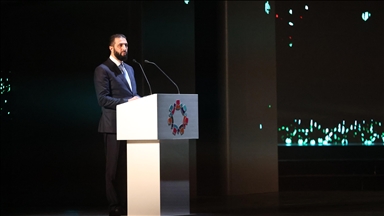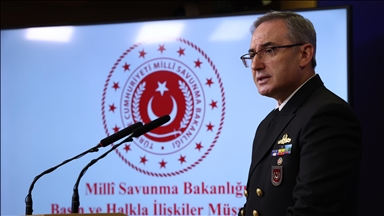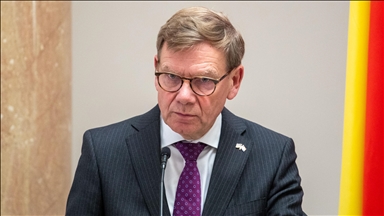
By Kasim Ileri
WASHINGTON
It has been four years since the first anti-government protests in Syria, but the conflict in the country rages on.
The civil war has left more than 220,000 dead and about half of the population, nearly 7 million citizens, have been displaced while 3.8 million of those took shelter in neighboring countries, according to UN data.
U.S. policy during the biggest humanitarian tragedy since the turn of the century has been marked by ambiguity and inconsistency.
President Barack Obama's administration has placed sanctions on Syrian President Bashar al-Assad, and called for him to step down months after the protests began but Washington failed to place sufficient pressure on Assad to relinquish power.
On the other hand, the White House said last week that the U.S. provided approximately $400 million in military aid to opposition Syrian fighters, most of which was non-lethal military aid or small arms and ammunitions.
The opposition has constantly complained about insufficient military aid to fight against the Assad regime forces.
According to the USAID, a U.S. government humanitarian aid agency, total U.S. assistance to the Syria humanitarian response since the beginning of the conflict in 2011 is more than $3 billion.
Despite of all assistance, the Obama administration's policy in Syria has been little more than a wish that Assad step down with a negotiated transition process.
Two rounds of talks, which were held in the Swiss cities of Geneva and Montreux, have so far failed, as well as several other UN attempts that have turned the civil war into a stalemate for the international community.
Assad’s forces used chemical weapons on civilians in mid 2013 which Obama defined as a "red line" but the despite proof of the use of such weapons, the U.S. did not take military action and came to terms with the regime on the destruction of Syria's chemical stockpile.
The elimination of chemical stockpiles was completed in June 2014.
The U.S., in cooperation with Turkey, Qatar and Saudi Arabia are working on a train-equip program for moderate Syrian opposition fighters, but that project is currently far from turning the tides in the war-torn country.
Below is a timeline of key U.S. actions and responses to the events in Syria compiled by The Anadolu Agency.
2011
- April 29 – U.S. imposes sanctions on Assad and senior Syrian officials for human rights abuses.
Obama's Executive Order 13573 blocks U.S. property owned by Assad and six other senior Syrian officials. It is Washington's first concrete steps in response to a crackdown on anti-government protests inspired by the "Arab Spring."
- Aug. 17 – U.S. freezes all assets of the Syrian government subject to U.S. jurisdiction
Executive Order 13582 bans Syrian oil imports and new U.S. investments in Syria, and blocks Syrian government property in the U.S.
- Aug. 18 – Obama for the first time explicitly calls for Assad to step down.
Leaders of the U.S., France, Germany and the UK issue coordinated statements calling on Assad to resign.
2012
- Feb. 6 – U.S. shut down embassy in Damascus
The United States shuts down its embassy in Damascus, citing security concerns following the attacks on U.S., U.K and France Embassies .
- April 22 – U.S. bans Syrians suspected of committing human rights abuses from accessing U.S. information technology.
Executive Order 13606 blocks all U.S. properties to be transferred, paid, and exported to, or withdrawn from Syrians suspected of committing human rights abuses using information technology.
- July 23 – Obama says Assad would be held accountable if found to have used Syria's stockpile of chemical weapons.
Obama's warning comes after Syrian government's threatens it could use chemical weapons in response to any "external aggression."
- Aug. 20 – Obama draws “red line” threatening U.S. military force if Assad’s regime deploys chemical weapons against opponents.
Obama says the U.S. would reconsider its opposition to military involvement in Syria if regime deploys or uses chemical or biological weapons, calling such action a "red line" for the United States.
- Sept. 28 – At Friends of Syria conference in New York, U.S. pledges $45 million in non-lethal and humanitarian aid for Syrian rebels.
- Dec. 10 – State Department designates al-Nusra Front a terrorist organization.
Nusra Front is a branch of al-Qaeda operating in Syria and Lebanon. The group announced its formation Jan. 23, 2012, during the Syrian civil war. Since early 2015, there have been persistent reports that al-Nusra Front is considering leaving al-Qaeda.
- Dec. 12 – Obama says the U.S. recognizes the Syrian National Coalition as “the legitimate representative” of the Syrian people.
The groups also known as the National Coalition for Syrian Revolutionary and Opposition Forces is a coalition of opposition groups in the Syrian civil war that was founded in Doha, Qatar, in November 2012 where the U.S. and several other Western powers joined.
2013
- Feb. 28 – At Friends of Syria meeting in Rome, the U.S. pledges $60 million in medical supplies and food for rebels. Syrian National Coalition expresses disappointment about the lack of military aid.
- April 21 – At Friends of Syria meeting in Istanbul, the U.S. pledges an additional $123 million in non-lethal aid to the Syrian opposition.
- April 25 – White House says U.S. intelligence have indications Assad twice used chemical weapons during the civil war, but says the information isn't solid enough to warrant quick U.S. involvement in the 2-year-old conflict.
- June 13 – U.S. officials conclude Assad used chemical weapons
The U.S. concludes that the Syrian government used chemical weapons in its fight against opposition forces, and Obama authorizes direct U.S. military support to the rebels, according to the White House.
- Aug. 26 – Secretary of State John Kerry condemns regime’s use of chemical weapons.
Kerry says it is “undeniable” that the regime used chemical weapons.
- Aug. 27 – Obama considers striking Syria.
A senior U.S. officials said Obama is weighing a military strike against Syria that would be of limited scope and duration, designed to serve as punishment for its use of chemical weapons and as a deterrent.
- Aug. 30 – U.S. intelligence says it found the track of the actual firing of chemical weapons in suburb of Damascus.
White House accuses regime of launching a chemical attack that killed 1,429 people in East Gouta on Aug. 21. Doctors Without Borders later reports that three hospitals near Damascus treated 3,600 patients who displayed neurotoxic symptoms, and 355 of the patients were subsequently pronounced dead.
An assessment by U.S. intelligence asserts it tracked the actual firing of chemical munitions, which were launched from government-held positions and landed in rebel-held or contested neighborhoods.
- Sept. 10 – Obama announces he asked Congress to postpone a vote to authorize the use of force against Syria while a diplomatic approach had been pursued.
- Sept. 14 – Facing the prospect of U.S. military intervention, Assad agrees to the complete removal or destruction of Syria's chemical weapons arsenal by a joint mission led by the UN and Organization for the Prohibition of Chemical Weapons, or OPCW, by 30 June 2014.
- Sept. 24 – Obama announces $339 million in new humanitarian aid for Syria; total U.S. humanitarian aid reaches nearly $1.4 billion.
2014
- June 23 – Joint OPCW-UN mission announces the removal of Syria's chemical weapons material is complete.
The U.S. says all of the most hazardous chemical agents have been destroyed on board a cargo vessel, the MV Cape Ray. The remaining chemicals would be destroyed at Finnish and British facilities.
- Aug. 20 – Daesh publishes online video showing the execution of James Foley, an American journalist who was abducted in northern Syria in 2012.
The terror group says Foley’s death was revenge for the U.S. military intervention in Iraq.
- Aug. 31 – Obama calls for congressional vote on Syria.
Obama says the U.S. has a moral responsibility to respond forcefully in Syria but he would not do so until Congress has a chance to vote on the use of military force.
- Sept. 11 – Obama authorizes U.S. airstrikes against Daesh inside Syria.
- Sept. 22 – Bombing raids by an American-led International Coalition (Bahrain, Jordan, Saudi Arabia, Qatar, and the United Arab Emirates) targets Daesh and Khorasan group, escalating the war to a new level.
The Khorasan Group, refers to a group of senior al-Qaeda members who operate in Syria and it is reportedly consists of a small number of fighters who are all on terrorist watch lists, and coordinate with the al-Nusra Front.
- Dec. 10 – A senior U.S. State Department official says Syria’s armed opposition would not be able to militarily defeat the Assad government.
2015
- Jan. 26 – U.S. airstrikes helps Kurdish forces to free Kobani, predominantly Kurdish town on the border with Turkey.
Since September 2014, Kobani had been under siege by Daesh militants, who as of November 2014, controlled the eastern parts of the town.
- Feb. 11 – Obama asks Congress for new wat powers to fight Daesh.
The proposal does not authorize the use of U.S. forces “in enduring offensive ground combat operations,” but leaves the door open for limited military engagements, such as rescue operations and special operations missions against Daesh's leadership.
- Feb. 19 – The U.S. and Turkey agrees “in principle” to train and equip Syrian rebels.
The U.S. is involved in a plan to train and quip moderate Syrian opposition to fight Daesh and Assad regime in Syria. Saudi Arabia, Qatar and Turkey agree to help opposition groups in that effort.
- March 13 – U.S. announces additional $70 million in non-lethal aid to the Syrian opposition.
Deputy Secretary of State Tony Blinken announce the new funds during an event marking the anniversary of the Syrian revolution.
Anadolu Agency website contains only a portion of the news stories offered to subscribers in the AA News Broadcasting System (HAS), and in summarized form. Please contact us for subscription options.







